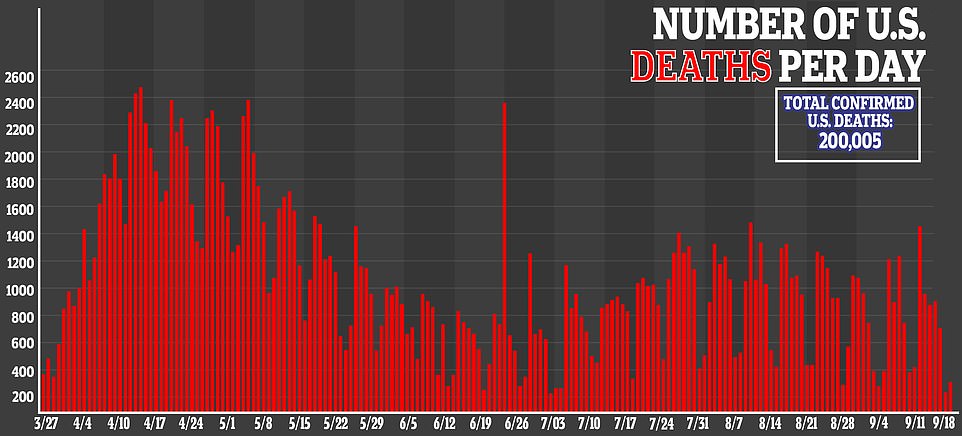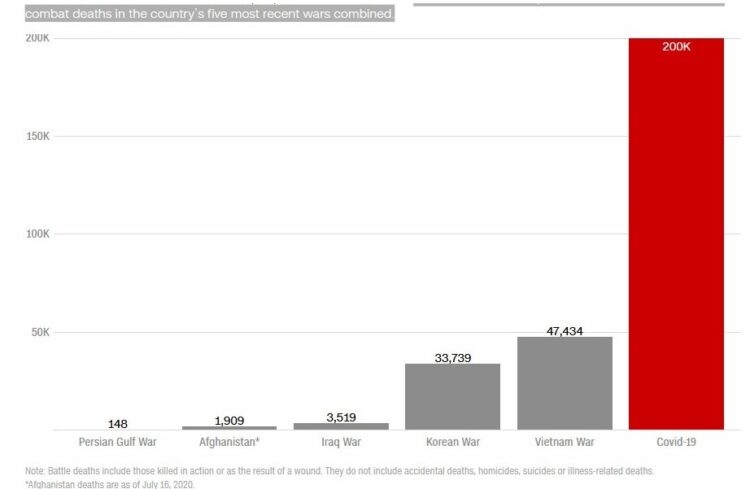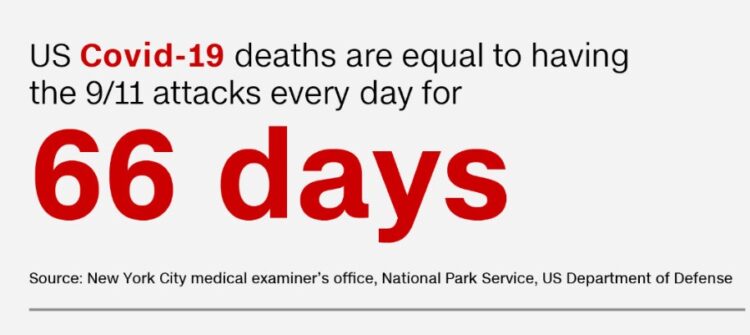The coronavirus, which was first confirmed in the United States about eight months ago, has killed more than 200,000 people across the country as of today as U.S. officials rush to approve and manufacture a vaccine.
The U.S. had reported at least 200,005 confirmed Covid-19 deaths as of mid-day today, more than any other country in the world, according to data compiled by Johns Hopkins University.
The death toll has surpassed the number of American combat deaths in the country’s five most recent wars combined.
The U.S., which accounts for roughly 21% of all confirmed Covid-19 deaths around the world despite having only 4% of the world’s population, is battling one of the deadliest outbreaks in the world.
Fatalities in the U.S. have doubled over the last four months, after the virus took 100,000 lives in the first four months of the outbreak.
The U.S. has reported about 61.09 deaths per 100,000 residents, making it the country with the 11th most deaths per capita, according to data from Hopkins.
Brazil, Chile, Spain, Bolivia, Peru and the United Kingdom among others have all reported more deaths per capita than the U.S., according to Hopkins data.
The virus has disproportionately killed people with underlying health conditions, such as obesity and asthma, and people who are older, according to data collected by the Centers for Disease Control and Prevention.
The virus has also disproportionately infected and killed Black and Hispanic people, as well as Native Americans, the CDC says.
The U.S. continues to report worryingly high numbers of new confirmed cases and deaths every day.
Over the past seven days, the country has reported an average of more than 43,300 new cases per day, up over 19% compared with a week ago, according to a CNBC analysis of Hopkins data.
And the country continues to report more than 750 Covid-19 deaths every day.
While doctors have new medications and treatment strategies to save the lives of Covid-19 patients, epidemiologists worry deaths could accelerate if the virus surges in the winter as expected.
“The worst is yet to come. I don’t think perhaps that’s a surprise, although I think there’s a natural tendency as we’re a little bit in the Northern hemisphere summer, to think maybe the epidemic is going away,” Dr. Christopher Murray, director of the Institute for Health Metrics and Evaluation at the University of Washington, said earlier this month.
IHME previously forecast that the U.S. would report more than 410,000 Covid-19 deaths by Jan. 1 due to the prospect of a “deadly December.”
The modeling group has since revised down its estimate, driven by “steeper than expected declines seen in deaths” in several states.
The group now projects that the U.S. will reach 378,000 deaths by the new year.
“Not only are these real people, but these are families that are suffering because they’ve lost loved ones, or they’re dealing with a loved one that has long-term health issues because of Covid-19,” said Dr. Syra Madad, senior director of the systemwide special pathogens program at New York City Health + Hospitals. “We’re only seeing the tip of the iceberg. We’re only nine months into this pandemic.”
Looking at deaths alone, though, provides an incomplete picture of the true toll of the pandemic, Madad said, because researchers are only just beginning to learn about the long-term health complications that Covid-19 causes.
She added that the death toll of 200,000 likely underestimates the total number of deaths caused either directly or indirectly by Covid-19.
Excess deaths studies, which compare projections based on historical death statistics with the number of actual deaths, seek to capture a more encompassing picture of the Covid-19 fatality count.
The CDC currently estimates more than 200,000 excess deaths in the U.S. since Feb. 1.
“I do believe that the true number of deaths associated with Covid-19 is much, much higher,” Madad said, adding that New York City is testing the bodies of people who have died over the past few months to best capture the Covid-19 death toll.
She said this data will help researchers understand the virus.
The Texas Department of State Health Services has reported more than 698,300 cases of the virus and over 14,900 Covid-19 deaths.
With new cases off the state’s peak, the governor is moving forward with reopening more businesses, including retail stores, gyms and restaurants.
Catherine Troisi, an infectious disease epidemiologist at UTHealth School of Public Health in Houston, said she’s concerned about the reopening plans, especially as she continues to examine the data for signs of a post-Labor Day surge.
She added that the reopening might send the wrong message, suggesting to the public that the virus is no longer a threat.
She said if the public fails to continue to adhere to public health protocol and if state policymakers don’t prioritize the pandemic response, the virus is a looming threat that could again overwhelm hospitals in the state.
“We absolutely, positively could have done better. There have been mistakes all along the way, and we’re still making some mistakes,” she said, adding that there is mixed messaging at the national and state level. “Could we have prevented all of those deaths? No, especially in the early stages, and even now, I’m sure, there are some deaths that can’t be prevented. But we could have prevented a great deal of them had the government acted quicker and if we had a national strategy, if we had not disinvested in public health.”


